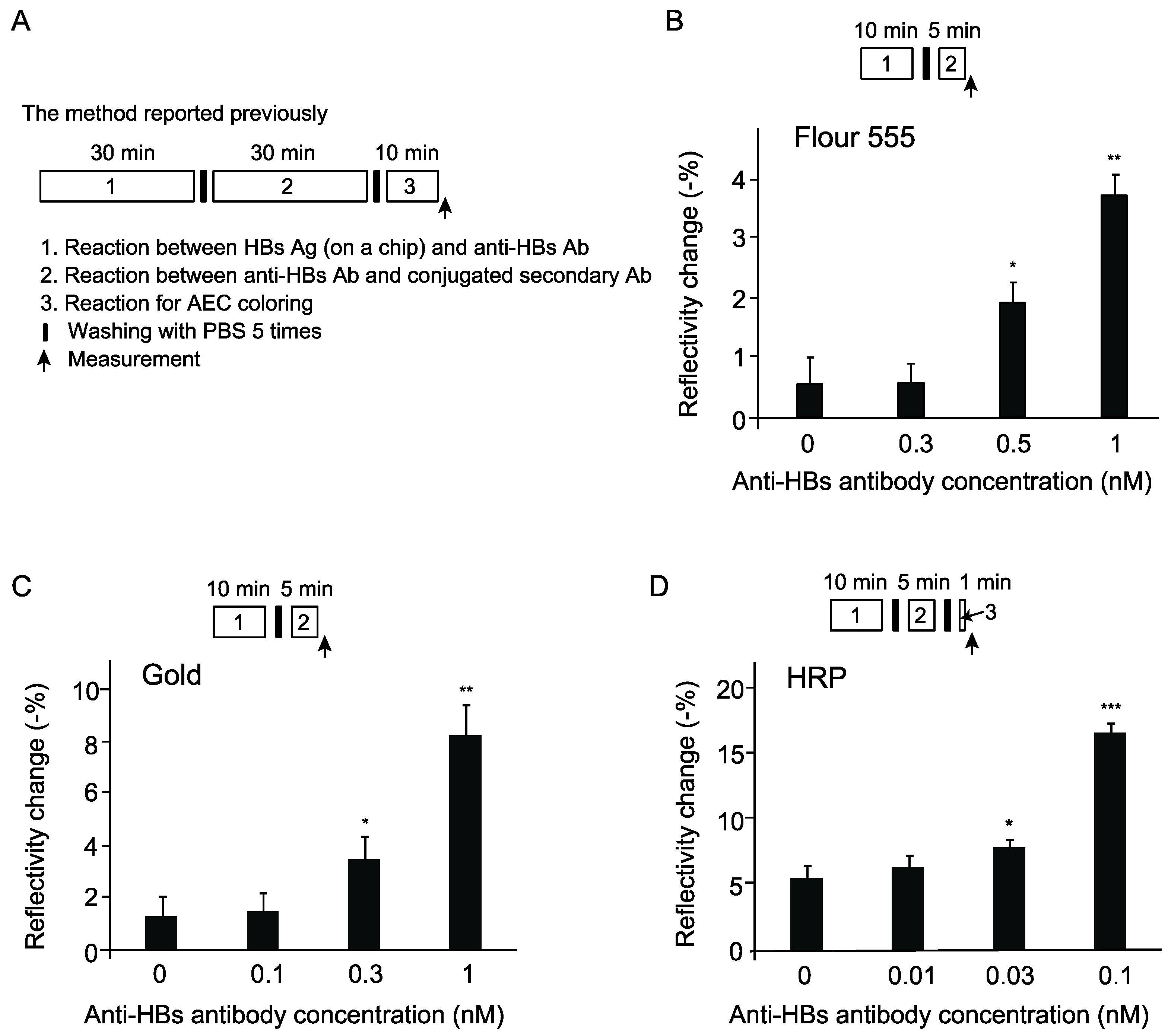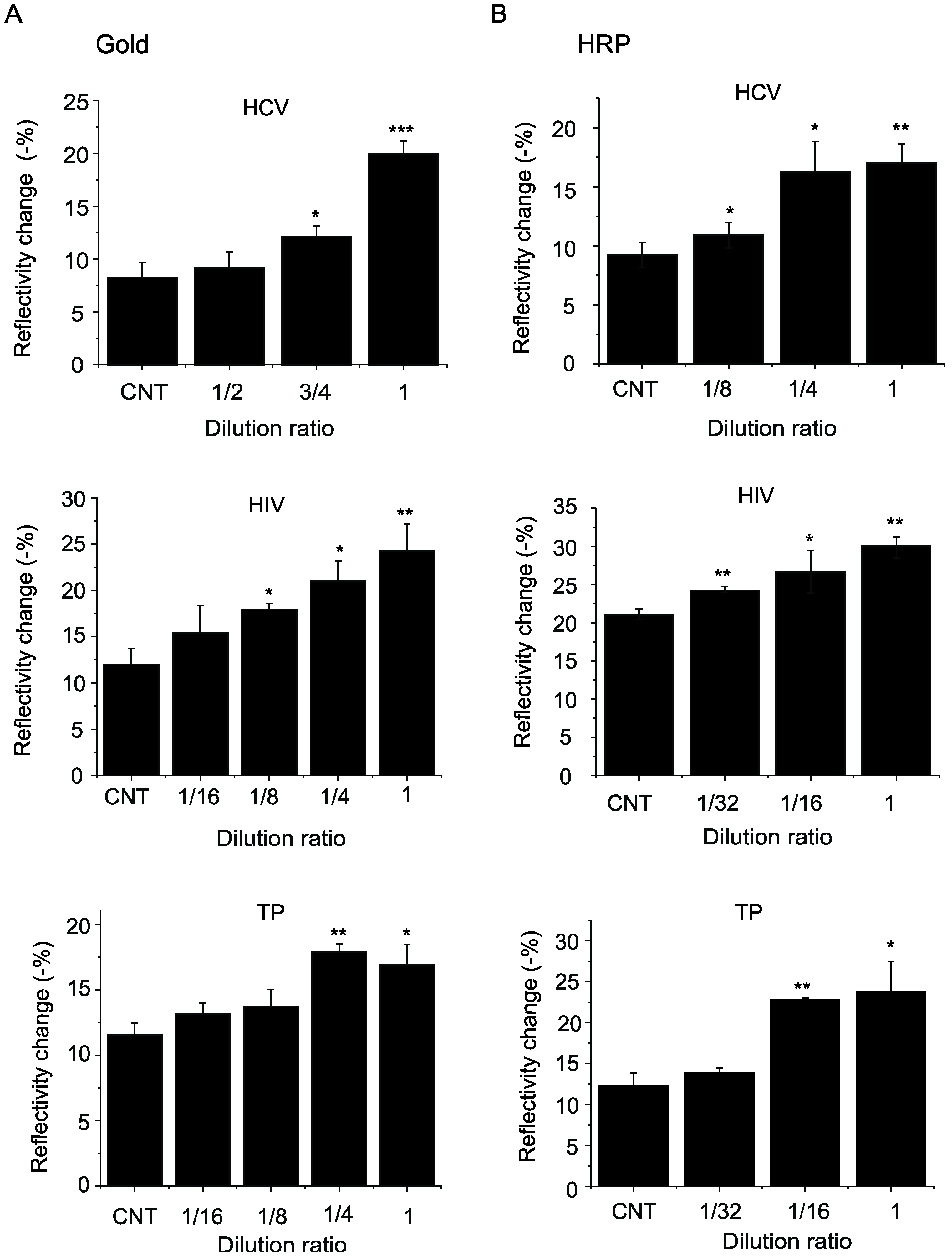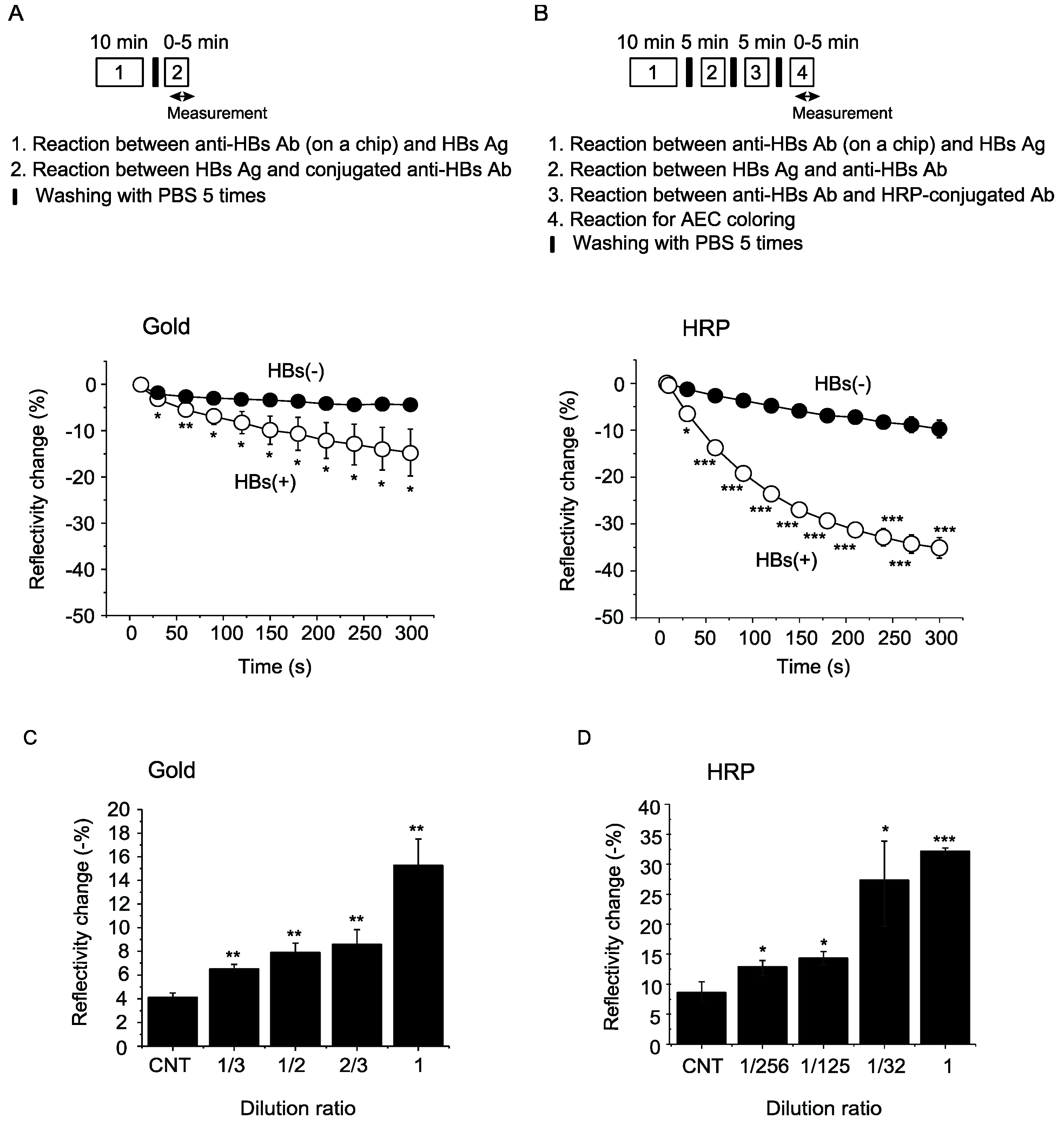Application of a Waveguide-Mode Sensor to Blood Testing for Hepatitis B Virus, Hepatitis C Virus, Human Immunodeficiency Virus and Treponema pallidum Infection
Abstract
1. Introduction
2. Materials and Methods
2.1. WM Sensors
2.2. Antigens and Antibodies
2.3. Fixation of Antigens and Antibodies on Sensor Chips
2.4. Detection of Mouse Monoclonal Anti-HBs Antibody with a WM Sensor
2.5. Detection of Antibodies against HCV, HIV and TP in Human Plasma with a WM Sensor
2.6. Detection of HBs Antigen in Human Plasma with a WM Sensor
2.7. Statistical Analysis
3. Results
3.1. Detection of Mouse Anti-HBs Antibody with a WM Sensor and Signal Enhancement Methods
3.2. Detection of Antibodies Against HCV, HIV and TP in Plasma with a WM Sensor
3.3. Detection of HBs Antigen in Human Plasma with a WM Sensor
4. Discussion
5. Conclusions
Author Contributions
Funding
Acknowledgments
Conflicts of Interest
References
- Taira, R.; Satake, M.; Momose, S.; Hino, S.; Suzuki, Y.; Murokawa, H.; Uchida, S.; Tadokoro, K. Residual risk of transfusion-transmitted hepatitis B virus (HBV) infection caused by blood components derived from donors with occult HBV infection in Japan. Transfusion 2013, 53, 1393–1404. [Google Scholar] [CrossRef] [PubMed]
- Tarantola, A.; Abiteboul, D.; Rachline, A. Infection risks following accidental exposure to blood or body fluids in health care workers: A review of pathogens transmitted in published cases. Am. J. Infect. Control 2006, 34, 367–375. [Google Scholar] [CrossRef]
- Nollet, K.E.; Komazawa, T.; Ohto, H. Transfusion under triple threat: Lessons from Japan’s 2011 earthquake, tsunami, and nuclear crisis. Transf. Apher. Sci. 2016, 55, 177–183. [Google Scholar] [CrossRef] [PubMed]
- Fujimaki, M.; Awazu, K. Development of high-sensitivity molecular adsorption detection sensors—Biomolecular detection for highly-developed diagnosis, medication, and medical treatments. Synthesiology 2009, 2, 142–153. [Google Scholar] [CrossRef]
- Fujimaki, M.; Rockstuhl, C.; Wang, X.; Awazu, K.; Tominaga, J.; Ikeda, T.; Koganezawa, Y.; Ohki, Y. Biomolecular sensors utilizing waveguide modes excited by evanescent fields. J. Microsc. 2008, 229, 320–326. [Google Scholar] [CrossRef]
- Fujimaki, M.; Rockstuhl, C.; Wang, X.; Awazu, K.; Tominaga, J.; Koganezawa, Y.; Ohki, Y.; Komatsubara, T. Silica-based monolithic sensing plates for waveguide-mode sensors. Opt. Express 2008, 16, 6408–6416. [Google Scholar] [CrossRef]
- Ashiba, H.; Fujimaki, M.; Awazu, K.; Fu, M.; Ohki, Y.; Tanaka, T.; Makishima, M. Hemagglutination detection for blood typing based on waveguide-mode sensors. Sens. Bio-Sens. Res. 2015, 3, 59–64. [Google Scholar] [CrossRef][Green Version]
- Ashiba, H.; Fujimaki, M.; Awazu, K.; Fu, M.; Ohki, Y.; Tanaka, T.; Makishima, M. Rapid detection of hemagglutination using restrictive microfluidic channels equipped with waveguide-mode sensors. Jpn. J. Appl. Phys. 2016, 55, 027002. [Google Scholar] [CrossRef]
- Uno, S.; Tanaka, T.; Ashiba, H.; Fujimaki, M.; Tanaka, M.; Hatta, Y.; Takei, M.; Awazu, K.; Makishima, M. Sensitive typing of reverse ABO blood groups with a waveguide-mode sensor. J. Biosci. Bioeng. 2018, 126, 131–137. [Google Scholar] [CrossRef] [PubMed]
- Shimizu, T.; Tanaka, T.; Uno, S.; Ashiba, H.; Fujimaki, M.; Tanaka, M.; Awazu, K.; Makishima, M. Detection of antibodies against hepatitis B virus surface antigen and hepatitis C virus core antigen in plasma with a waveguide-mode sensor. J. Biosci. Bioeng. 2017, 123, 760–764. [Google Scholar] [CrossRef]
- Fujimaki, M.; Nomura, K.; Sato, K.; Kato, T.; Gopinath, S.C.; Wang, X.; Awazu, K.; Ohki, Y. Detection of colored nanomaterials using evanescent field-based waveguide sensors. Opt. Express 2010, 18, 15732–15740. [Google Scholar] [CrossRef]
- Gopinath, S.C.; Awazu, K.; Fujimaki, M.; Shimizu, K.; Shima, T. Observations of immuno-gold conjugates on influenza viruses using waveguide-mode sensors. PLoS ONE 2013, 8, e69121. [Google Scholar] [CrossRef]
- Kubitschko, S.; Spinke, J.; Bruckner, T.; Pohl, S.; Oranth, N. Sensitivity enhancement of optical immunosensors with nanoparticles. Anal. Biochem. 1997, 253, 112–122. [Google Scholar] [CrossRef]
- He, L.; Musick, M.D.; Nicewarner, S.R.; Salinas, F.G.; Benkovic, S.J.; Natan, M.J.; Keating, C.D. Colloidal au-enhanced surface plasmon resonance for ultrasensitive detection of DNA hybridization. J. Am. Chem. Soc. 2000, 122, 9071–9077. [Google Scholar] [CrossRef]
- Mitchell, J.S.; Wu, Y.; Cook, C.J.; Main, L. Sensitivity enhancement of surface plasmon resonance biosensing of small molecules. Anal. Biochem. 2005, 343, 125–135. [Google Scholar] [CrossRef]
- Fujimaki, M.; Wang, X.; Kato, T.; Awazu, K.; Ohki, Y. Parallel-incidence-type waveguide-mode sensor with spectral-readout setup. Opt. Express 2015, 23, 10925–10937. [Google Scholar] [CrossRef]
- Tanaka, M.; Yoshioka, K.; Hirata, Y.; Fujimaki, M.; Kuwahara, M.; Niwa, O. Design and fabrication of biosensing interface for waveguide-mode sensor. Langmuir 2013, 29, 13111–13120. [Google Scholar] [CrossRef]
- Chung, J.W.; Kim, S.D.; Bernhardt, R.; Pyun, J.C. Application of spr biosensor for medical diagnostics of human hepatitis B virus (hHBV). Sens. Actuators B Chem. 2005, 111–112, 416–422. [Google Scholar] [CrossRef]
- Kuroda, C.; Ohki, Y.; Ashiba, H.; Fujimaki, M.; Awazu, K.; Makishima, M. Design of a sedimentation hole in a microfluidic channel to remove blood cells from diluted whole blood. Jpn. J. Appl. Phys. 2017, 56, 037201. [Google Scholar] [CrossRef]
- Kosack, C.S.; Nick, S.; Shanks, L. Diagnostic accuracy evaluation of the ImmunoFlow HCV rapid immunochromatographic test for the detection of hepatitis C antibodies. J. Virol. Methods 2014, 204, 6–10. [Google Scholar] [CrossRef]
- Bystryak, S.; Ossina, N. A rapid ultrasound particle agglutination method for HIV antibody detection: Comparison with conventional rapid HIV tests. J. Virol. Methods 2017, 249, 38–47. [Google Scholar] [CrossRef] [PubMed]
- Poltavchenko, A.G.; Nechitaylo, O.V.; Filatov, P.V.; Ersh, A.V.; Gureyev, V.N. Multiplex method for initial complex testing of antibodies to blood transmitted diseases agents. J. Virol. Methods 2016, 236, 231–236. [Google Scholar] [CrossRef] [PubMed]
- Yang, R.; Song, G.; Guan, W.; Wang, Q.; Liu, Y.; Wei, L. The Lumipulse G HBsAg-Quant assay for screening and quantification of the hepatitis B surface antigen. J. Virol. Methods 2016, 228, 39–47. [Google Scholar] [CrossRef] [PubMed]





© 2019 by the authors. Licensee MDPI, Basel, Switzerland. This article is an open access article distributed under the terms and conditions of the Creative Commons Attribution (CC BY) license (http://creativecommons.org/licenses/by/4.0/).
Share and Cite
Uno, S.; Shimizu, T.; Tanaka, T.; Ashiba, H.; Fujimaki, M.; Tanaka, M.; Awazu, K.; Makishima, M. Application of a Waveguide-Mode Sensor to Blood Testing for Hepatitis B Virus, Hepatitis C Virus, Human Immunodeficiency Virus and Treponema pallidum Infection. Sensors 2019, 19, 1729. https://doi.org/10.3390/s19071729
Uno S, Shimizu T, Tanaka T, Ashiba H, Fujimaki M, Tanaka M, Awazu K, Makishima M. Application of a Waveguide-Mode Sensor to Blood Testing for Hepatitis B Virus, Hepatitis C Virus, Human Immunodeficiency Virus and Treponema pallidum Infection. Sensors. 2019; 19(7):1729. https://doi.org/10.3390/s19071729
Chicago/Turabian StyleUno, Shigeyuki, Takenori Shimizu, Torahiko Tanaka, Hiroki Ashiba, Makoto Fujimaki, Mutsuo Tanaka, Koichi Awazu, and Makoto Makishima. 2019. "Application of a Waveguide-Mode Sensor to Blood Testing for Hepatitis B Virus, Hepatitis C Virus, Human Immunodeficiency Virus and Treponema pallidum Infection" Sensors 19, no. 7: 1729. https://doi.org/10.3390/s19071729
APA StyleUno, S., Shimizu, T., Tanaka, T., Ashiba, H., Fujimaki, M., Tanaka, M., Awazu, K., & Makishima, M. (2019). Application of a Waveguide-Mode Sensor to Blood Testing for Hepatitis B Virus, Hepatitis C Virus, Human Immunodeficiency Virus and Treponema pallidum Infection. Sensors, 19(7), 1729. https://doi.org/10.3390/s19071729




